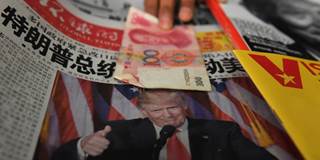The Trump administration seems set on pursuing a destructive protectionist path. But, rather than retaliate, Asian economies should use the threat of broader US tariffs as an opportunity to revamp their development models, thereby boosting their own prosperity and resilience, not to mention their positions as constructive global actors.
SEOUL – Over the last five decades or so, Asia’s economies have relied largely on an export-oriented development model to support rapid economic transformation and growth. But with US President Donald Trump fulfilling his promise to adopt a more protectionist approach to trade – an effort that could spur retaliatory measures by other countries – that model is coming under increasing strain.
In the last year, Trump has withdrawn the US from the Trans-Pacific Partnership (TPP), renegotiated its free-trade agreement with South Korea, and raised “safeguard” tariffs on imported washing machines and solar panels from China and South Korea. Now, the White House has announced steep tariffs on steel and aluminum, supposedly to strengthen national security. And it is set to impose punitive tariffs on a range of Chinese goods over alleged intellectual-property theft.
This is a startling reversal for the United States, which has served as the world’s main champion of free trade since the 1930s. Of course, some of Trump’s predecessors adopted protectionist policies; but those arose out of actual negotiations with trade partners. As Harvard’s Dani Rodrik has put it, “Trump’s trade restrictions have more of a unilateral, in-your-face quality.”

SEOUL – Over the last five decades or so, Asia’s economies have relied largely on an export-oriented development model to support rapid economic transformation and growth. But with US President Donald Trump fulfilling his promise to adopt a more protectionist approach to trade – an effort that could spur retaliatory measures by other countries – that model is coming under increasing strain.
In the last year, Trump has withdrawn the US from the Trans-Pacific Partnership (TPP), renegotiated its free-trade agreement with South Korea, and raised “safeguard” tariffs on imported washing machines and solar panels from China and South Korea. Now, the White House has announced steep tariffs on steel and aluminum, supposedly to strengthen national security. And it is set to impose punitive tariffs on a range of Chinese goods over alleged intellectual-property theft.
This is a startling reversal for the United States, which has served as the world’s main champion of free trade since the 1930s. Of course, some of Trump’s predecessors adopted protectionist policies; but those arose out of actual negotiations with trade partners. As Harvard’s Dani Rodrik has put it, “Trump’s trade restrictions have more of a unilateral, in-your-face quality.”